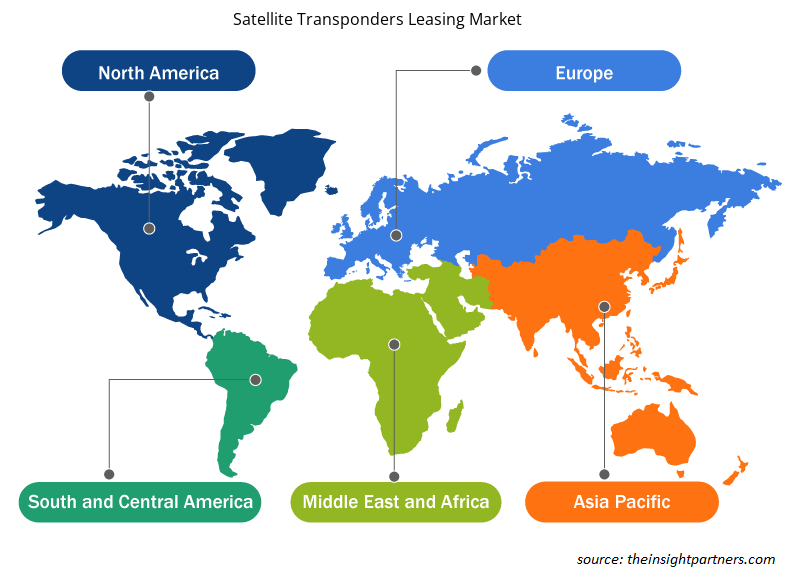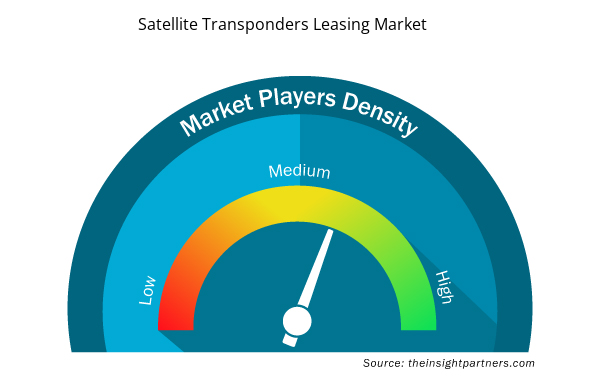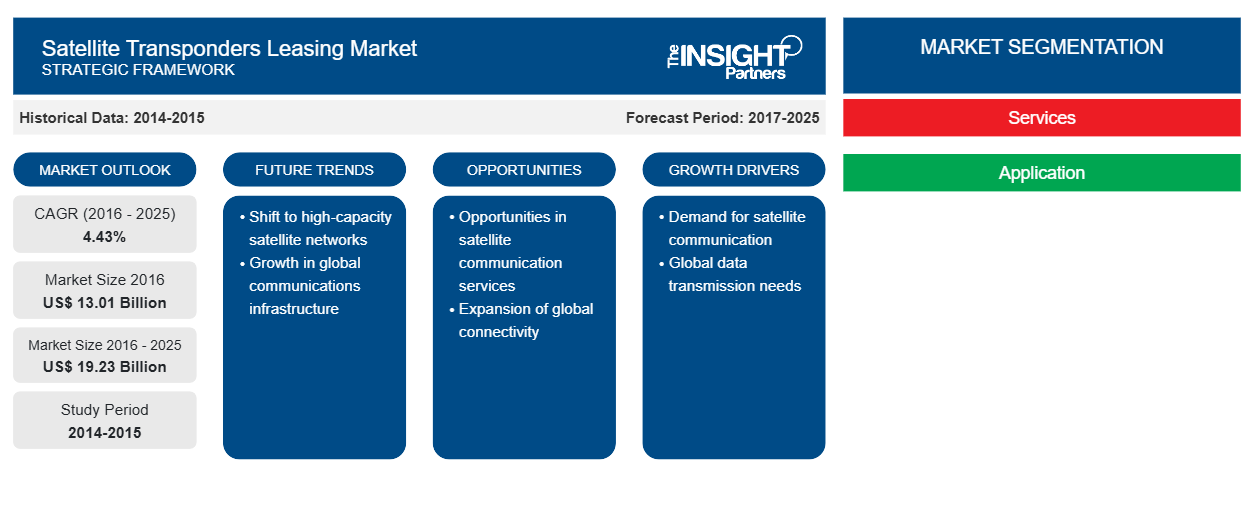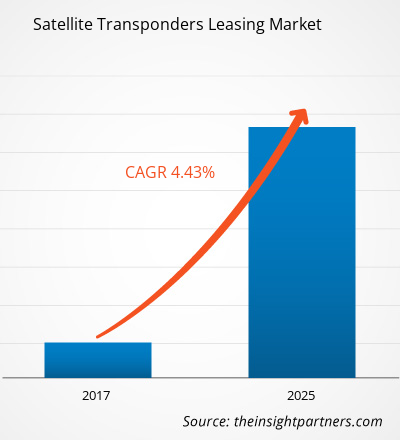Si prevede che il mercato del leasing dei transponder satellitari crescerà da 13,01 miliardi di dollari nel 2016 a 19,23 miliardi di dollari entro il 2025, con un CAGR del 4,43% tra il 2016 e il 2025.
Si prevede che il mercato del leasing dei transponder satellitari crescerà in termini sia di copertura che di capacità, poiché le frequenze in banda Ka e Ku sono atte ad alimentare la crescita del mercato; inoltre, si prevede che il numero crescente di aggiornamenti degli abbonati e di nuovi abbonati guiderà il mercato globale dei transponder satellitari. Inoltre, grazie agli attuali progressi tecnologici nelle comunicazioni satellitari, si prevede che emergeranno diverse nuove applicazioni dei transponder satellitari. Si ritiene che questi satelliti siano abbastanza potenti da competere con la loro rivalità; la banda larga Digital Subscriber Line (DSL) in termini di prestazioni. Si prevede che tutti questi fattori alimenteranno il mercato globale del leasing dei transponder satellitari durante il periodo di previsione.
Approfondimenti di mercato
Espansione delle applicazioni in banda Ku per generare nuove opportunità per il mercato del leasing dei transponder satellitari per comunicazioni
La trasmissione in diretta e la distribuzione video sono alcune delle principali applicazioni dei satelliti in banda Ku, inoltre sono utilizzati per diversi servizi dati, tra cui servizi VSAT, connettività a banda larga, backhaul mobile, servizi aeronautici e marittimi. In questo mondo altamente connesso, tutte queste applicazioni sono considerate critiche per il funzionamento di un'azienda/ditta. Infatti, la banda Ku è lo spettro principale utilizzato dalle reti di mobilità per fornire connettività a banda larga nell'area in cui le reti terrestri non possono arrivare, vale a dire, sopra l'oceano e nella troposfera. La banda Ku cattura circa il 40% del mercato in termini di larghezza di banda. Si prevede che la domanda di transponder in banda Ku aumenterà a causa della crescente moda delle TV satellitari, in particolare nelle economie in via di sviluppo, che è ulteriormente supportata dall'HD (alta definizione) e dalla domanda di altre applicazioni di larghezza di banda simili. Si prevede che l'evoluzione dei canali 3D che consumano una larghezza di banda maggiore e richiedono il 50% in più di capacità offrirà una nuova spinta al mercato dei transponder satellitari in banda Ku. Seguiti da Ku-Band sono i transponder in banda C che detengono attualmente la quota di mercato maggiore, ma si prevede un calo costante durante il periodo di previsione, perdendo la loro importanza rispetto a Ku e altre larghezze di banda simili. Quindi, si prevede che questa espansione nelle applicazioni in banda Ku genererà nuove opportunità per il mercato del leasing di transponder satellitari
Il leasing di transponder come servizi dominerà il segmento di servizio globale del mercato del leasing di transponder satellitari
Negli ultimi uno o due anni il mercato globale dei transponder satellitari ha assistito a un aumento di circa il 4,3-4,5% della domanda di transponder in leasing. Si prevede che questo aumenterà ulteriormente a causa del costo a valanga dei transponder in tutto il mondo. Guardando al mercato del leasing dei transponder satellitari, l'Europa è nota per essere la regione più costosa, seguita da Australia e Nuova Zelanda. Mentre, l'Asia meridionale offre i tassi di leasing più bassi, motivo per cui l'Asia Pacifica è considerata la regione più promettente per il mercato del leasing dei transponder satellitari nei prossimi anni. Di recente, una società satellitare coreana KT SAT ha firmato un accordo di leasing di transponder con un operatore di TV satellitare mongolo, il fornitore di servizi KT SAT ha affiliato il leasing di quattro transponder, che soddisferebbero lo scopo di offrire servizi DTH alle società mongole che saranno avviate nel prossimo anno. Mentre, si prevede che la società TV DDISH trarrà vantaggio dai servizi KT SAT nel 2017. Il leasing di transponder satellitari per comunicazioni dipende in larga misura dall'adozione della trasmissione video HD e da una diffusione di applicazioni High Dynamic Range (HDR). Sebbene si preveda che i servizi di leasing guideranno il mercato del leasing dei transponder satellitari con una quota di mercato relativamente più elevata, questa è soggetta a fluttuazioni a seconda della revisione del costo di acquisto dei transponder satellitari e del costo totale del lancio di un satellite e della sua manutenzione.
Personalizza questo report in base alle tue esigenze
Riceverai la personalizzazione gratuita di qualsiasi report, comprese parti di questo report, o analisi a livello nazionale, pacchetto dati Excel, oltre a usufruire di grandi offerte e sconti per start-up e università
- Scopri le principali tendenze di mercato in questo rapporto.Questo campione GRATUITO includerà analisi di dati che spaziano dalle tendenze di mercato alle stime e alle previsioni.
L'iniziativa di mercato è stata osservata come la strategia più adottata nel mercato globale del leasing dei transponder satellitari. Di seguito sono elencate alcune delle strategie recenti di alcuni dei player nel panorama del mercato del leasing dei transponder satellitari:
2016: GlobalSat ottiene la licenza Inmarsat Ka, servizi a banda L in tutto il Messico
2016: MVS USA aggiorna la rete Satcom con un occhio alla sicurezza informatica
2016: O3b e Ozonio portano la banda larga in un'altra città amazzonica in Brasile
2016: le scuole africane trarranno beneficio dal nuovo accordo Gazprom-Gilat
2016: L'Indonesia costruisce l'accesso alla banda larga nelle aree sottoservite con Newtec
Approfondimenti regionali sul mercato del leasing dei transponder satellitari
Le tendenze regionali e i fattori che influenzano il mercato del leasing dei transponder satellitari durante il periodo di previsione sono stati ampiamente spiegati dagli analisti di Insight Partners. Questa sezione discute anche i segmenti e la geografia del mercato del leasing dei transponder satellitari in Nord America, Europa, Asia Pacifico, Medio Oriente e Africa e America centrale e meridionale.

- Ottieni i dati specifici regionali per il mercato del leasing dei transponder satellitari
Ambito del rapporto sul mercato del leasing di transponder satellitari
| Attributo del report | Dettagli |
|---|---|
| Dimensioni del mercato nel 2016 | 13,01 miliardi di dollari USA |
| Dimensioni del mercato entro il 2025 | 19,23 miliardi di dollari USA |
| CAGR globale (2016-2025) | 4,43% |
| Dati storici | 2014-2015 |
| Periodo di previsione | 2017-2025 |
| Segmenti coperti | Per serviziPer applicazionePer larghezza di banda |
| Regioni e Paesi coperti | America del Nord
|
| Leader di mercato e profili aziendali chiave |
|
Densità degli attori del mercato: comprendere il suo impatto sulle dinamiche aziendali
Il mercato del leasing di transponder satellitari sta crescendo rapidamente, spinto dalla crescente domanda degli utenti finali dovuta a fattori quali l'evoluzione delle preferenze dei consumatori, i progressi tecnologici e una maggiore consapevolezza dei vantaggi del prodotto. Con l'aumento della domanda, le aziende stanno ampliando le loro offerte, innovando per soddisfare le esigenze dei consumatori e capitalizzando sulle tendenze emergenti, il che alimenta ulteriormente la crescita del mercato.
La densità degli operatori di mercato si riferisce alla distribuzione di aziende o società che operano in un particolare mercato o settore. Indica quanti concorrenti (operatori di mercato) sono presenti in un dato spazio di mercato in relazione alle sue dimensioni o al valore di mercato totale.
Le principali aziende che operano nel mercato del leasing di transponder satellitari sono:
- Intelsat
- SES
- Eutelsat
- Telesat
- SingTel Optus
Disclaimer : le aziende elencate sopra non sono classificate secondo un ordine particolare.

- Ottieni una panoramica dei principali attori del mercato del leasing di transponder satellitari
Leasing di transponder satellitari globali - Segmentazione del mercato
Per servizi
- Protetto
- Non protetto
- Preemptabile
Per applicazione
- Governo e esercito
- Telecom
- Commerciale
- Ricerca e sviluppo
- Navigazione
- Telerilevamento
Per larghezza di banda
- Banda Ku
- Banda Ka
- Banda C
- Altri (S, L, X e K)
Per Geografia
- America del Nord
- NOI
- Canada
- Messico
- Europa
- Russia
- Francia
- Germania
- Regno Unito
- Lussemburgo
- Resto d'Europa
- Asia Pacifico (APAC)
- Cina
- India
- Giappone
- Resto dell'APAC
- Medio Oriente e Africa (MEA)
- Arabia Saudita
- Sudafrica
- Israele
- Emirati Arabi Uniti
- Resto del MEA
- America del Sud (SAM)
- Brasile
- Argentina
- Resto del SAM
Profili aziendali
- Intelsat
- SES
- Eutelsat
- Telesat
- SingTel Optus
- Sistemi satellitari MEASAT
- Satellite di trasmissione in Asia
- Arabo
- ISRO
- Società cinese di comunicazioni satellitari
- Analisi storica (2 anni), anno base, previsione (7 anni) con CAGR
- Analisi PEST e SWOT
- Valore/volume delle dimensioni del mercato - Globale, regionale, nazionale
- Industria e panorama competitivo
- Set di dati Excel



Report Coverage
Revenue forecast, Company Analysis, Industry landscape, Growth factors, and Trends

Segment Covered
This text is related
to segments covered.

Regional Scope
North America, Europe, Asia Pacific, Middle East & Africa, South & Central America

Country Scope
This text is related
to country scope.
Trends and growth analysis reports related to Aerospace and Defense : READ MORE..
The List of Companies - Satellite Transponders Leasing Market
- Intelsat
- SES
- Eutelsat
- Telesat
- SingTel Optus
- MEASAT satellite systems
- Asia Broadcast Satellite
- Arabsat
- ISRO
- China Satellite Communications Co.
The Insight Partners performs research in 4 major stages: Data Collection & Secondary Research, Primary Research, Data Analysis and Data Triangulation & Final Review.
- Data Collection and Secondary Research:
As a market research and consulting firm operating from a decade, we have published and advised several client across the globe. First step for any study will start with an assessment of currently available data and insights from existing reports. Further, historical and current market information is collected from Investor Presentations, Annual Reports, SEC Filings, etc., and other information related to company’s performance and market positioning are gathered from Paid Databases (Factiva, Hoovers, and Reuters) and various other publications available in public domain.
Several associations trade associates, technical forums, institutes, societies and organization are accessed to gain technical as well as market related insights through their publications such as research papers, blogs and press releases related to the studies are referred to get cues about the market. Further, white papers, journals, magazines, and other news articles published in last 3 years are scrutinized and analyzed to understand the current market trends.
- Primary Research:
The primarily interview analysis comprise of data obtained from industry participants interview and answers to survey questions gathered by in-house primary team.
For primary research, interviews are conducted with industry experts/CEOs/Marketing Managers/VPs/Subject Matter Experts from both demand and supply side to get a 360-degree view of the market. The primary team conducts several interviews based on the complexity of the markets to understand the various market trends and dynamics which makes research more credible and precise.
A typical research interview fulfils the following functions:
- Provides first-hand information on the market size, market trends, growth trends, competitive landscape, and outlook
- Validates and strengthens in-house secondary research findings
- Develops the analysis team’s expertise and market understanding
Primary research involves email interactions and telephone interviews for each market, category, segment, and sub-segment across geographies. The participants who typically take part in such a process include, but are not limited to:
- Industry participants: VPs, business development managers, market intelligence managers and national sales managers
- Outside experts: Valuation experts, research analysts and key opinion leaders specializing in the electronics and semiconductor industry.
Below is the breakup of our primary respondents by company, designation, and region:

Once we receive the confirmation from primary research sources or primary respondents, we finalize the base year market estimation and forecast the data as per the macroeconomic and microeconomic factors assessed during data collection.
- Data Analysis:
Once data is validated through both secondary as well as primary respondents, we finalize the market estimations by hypothesis formulation and factor analysis at regional and country level.
- Macro-Economic Factor Analysis:
We analyse macroeconomic indicators such the gross domestic product (GDP), increase in the demand for goods and services across industries, technological advancement, regional economic growth, governmental policies, the influence of COVID-19, PEST analysis, and other aspects. This analysis aids in setting benchmarks for various nations/regions and approximating market splits. Additionally, the general trend of the aforementioned components aid in determining the market's development possibilities.
- Country Level Data:
Various factors that are especially aligned to the country are taken into account to determine the market size for a certain area and country, including the presence of vendors, such as headquarters and offices, the country's GDP, demand patterns, and industry growth. To comprehend the market dynamics for the nation, a number of growth variables, inhibitors, application areas, and current market trends are researched. The aforementioned elements aid in determining the country's overall market's growth potential.
- Company Profile:
The “Table of Contents” is formulated by listing and analyzing more than 25 - 30 companies operating in the market ecosystem across geographies. However, we profile only 10 companies as a standard practice in our syndicate reports. These 10 companies comprise leading, emerging, and regional players. Nonetheless, our analysis is not restricted to the 10 listed companies, we also analyze other companies present in the market to develop a holistic view and understand the prevailing trends. The “Company Profiles” section in the report covers key facts, business description, products & services, financial information, SWOT analysis, and key developments. The financial information presented is extracted from the annual reports and official documents of the publicly listed companies. Upon collecting the information for the sections of respective companies, we verify them via various primary sources and then compile the data in respective company profiles. The company level information helps us in deriving the base number as well as in forecasting the market size.
- Developing Base Number:
Aggregation of sales statistics (2020-2022) and macro-economic factor, and other secondary and primary research insights are utilized to arrive at base number and related market shares for 2022. The data gaps are identified in this step and relevant market data is analyzed, collected from paid primary interviews or databases. On finalizing the base year market size, forecasts are developed on the basis of macro-economic, industry and market growth factors and company level analysis.
- Data Triangulation and Final Review:
The market findings and base year market size calculations are validated from supply as well as demand side. Demand side validations are based on macro-economic factor analysis and benchmarks for respective regions and countries. In case of supply side validations, revenues of major companies are estimated (in case not available) based on industry benchmark, approximate number of employees, product portfolio, and primary interviews revenues are gathered. Further revenue from target product/service segment is assessed to avoid overshooting of market statistics. In case of heavy deviations between supply and demand side values, all thes steps are repeated to achieve synchronization.
We follow an iterative model, wherein we share our research findings with Subject Matter Experts (SME’s) and Key Opinion Leaders (KOLs) until consensus view of the market is not formulated – this model negates any drastic deviation in the opinions of experts. Only validated and universally acceptable research findings are quoted in our reports.
We have important check points that we use to validate our research findings – which we call – data triangulation, where we validate the information, we generate from secondary sources with primary interviews and then we re-validate with our internal data bases and Subject matter experts. This comprehensive model enables us to deliver high quality, reliable data in shortest possible time.


 Ottieni un campione gratuito per questo repot
Ottieni un campione gratuito per questo repot